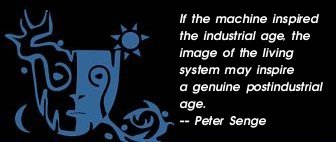|

What Do We Really See?
Notes from Alex Escobar Lecture
Mary Davis
Image: The Side Show by George Seurat
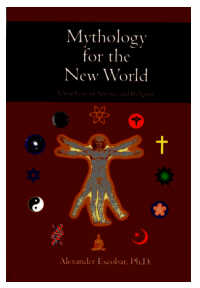 As I write this article, I think of Michael Meade and others who discuss "the world behind the world." And I think especially of the discussion in Chapter 11 of the Bhagavad Gita between Lord Krsna (Krishna) and Arjuna when Arjuna asks Krsna to show him Reality. Lord Krsna grants divine sight to this one human being, Arjuna, and then reveals Krsna's Universal Form, Ultimate Reality, to him. Reality is described as the radiance, the fire of a thousand suns simultaneously blazing forth in the sky. Arjuna is overwhelmed with ecstasy, his body's hairs stand on end, and he trembles with fear. He sees Krsna (Ultimate Reality) without beginning, middle or end; with infinite energy; with multitudes of arms, tusks, weapons, fragrant perfumes, faces, bellies, fiery eyes; and with fire blazing from thousands of devouring mouths, so that all of the universes are scorched! Arjuna in wonder and absolute terror begs Krsna for mercy and relief. Krsna explains to Arjuna that He is Time, the destroyer of all beings in all worlds. After he explains that Arjuna must accept his dharma and take action in the battle facing him, Krsna grants Arjuna's request to return to human sight and illusion, and Krsna returns to his "human" manifestation as Arjuna's charioteer on the field of battle. As I write this article, I think of Michael Meade and others who discuss "the world behind the world." And I think especially of the discussion in Chapter 11 of the Bhagavad Gita between Lord Krsna (Krishna) and Arjuna when Arjuna asks Krsna to show him Reality. Lord Krsna grants divine sight to this one human being, Arjuna, and then reveals Krsna's Universal Form, Ultimate Reality, to him. Reality is described as the radiance, the fire of a thousand suns simultaneously blazing forth in the sky. Arjuna is overwhelmed with ecstasy, his body's hairs stand on end, and he trembles with fear. He sees Krsna (Ultimate Reality) without beginning, middle or end; with infinite energy; with multitudes of arms, tusks, weapons, fragrant perfumes, faces, bellies, fiery eyes; and with fire blazing from thousands of devouring mouths, so that all of the universes are scorched! Arjuna in wonder and absolute terror begs Krsna for mercy and relief. Krsna explains to Arjuna that He is Time, the destroyer of all beings in all worlds. After he explains that Arjuna must accept his dharma and take action in the battle facing him, Krsna grants Arjuna's request to return to human sight and illusion, and Krsna returns to his "human" manifestation as Arjuna's charioteer on the field of battle.
So what is this world we "see" and perceive with our senses? Is it "reality"?
In June, Atlanta's Mythological Roundtable (aka Joseph Campbell Roundtable) met for a lecture and discussion (arranged by Dennis Papp) with Alex Escobar (W. Alexander Escobar, Ph.D.), a young man who has studied genetics and biochemistry and who currently teaches biology at Emory University. Escobar's book is Mythology for the New World: A Synthesis of Science and Religion, published in 2005.
Alex Escobar had just returned from Dharamsala, India as a member of an Emory group of scientists who are involved in an exchange of knowledge with Tibetan Buddhist monks. The knowledge exchange is part of Emory University's ongoing relationship with the Dalai Lama. The Emory scientists learn about Tibetan Buddhist meditation and the monks' worldviews, and the Tibetan monks learn about modern Western science and scientific worldviews.
Escobar began with quotes from Joseph Campbell's The Hero With a Thousand Faces and a discussion of connections, wholeness, and unity in the human experience. He spoke of modern science's reductionistic approach to "reality" and religion's focus on a "wholeness" approach to "reality," although he believes that science is now moving towards "wholeness" also.
Then, he moved to a very detailed and clear discussion of human sensory perception. He showed us detailed images of the brain, and described our sensory tools for perception which lead us to "see" our world so differently from the way other creatures perceive this world. As he discussed electromagnetic radiation and the fact that we "see" only a sliver of the spectrum, he explained that insects can see ultraviolet light... they can "see" the intricate patterns (in the ultraviolet range) on flowers. Salmon sense electromagnetic fields. He asked, "What does smell (odor) look like to a dog? Do dogs see from the neural connections to their brains from their noses?" We then saw Escobar's map of the brain, his diagram of the eye and its cells, and we listened as he discussed the ways the brain translates the images sent to the occipital cortex, the ways the brain creates the sensation of movement, the ways the brain works with patterns. He asked how we get from neurons exciting each other to perception, to seeing, to awareness, to consciousness?
Escobar continued, "Our five senses evolved for survivability, and probably are the minimum necessary for our survival. There is so much of the universe which we cannot and do not see... We do now know from instrumentation developed just in the last fifty years more about some of what's out there in the universe."
He posits that something must be "in between" the level of the neuron and a brain. He also says awareness seems to be a natural aspect of the universe outside the brain, noting as an example the periodic table of elements, patterns of energy which have specific properties associated with them.
He feels we produce bits of awareness in our brain's cortex, and he calls them "qualia" and compares them to bits of matter, protons. In noting Seurat's paintings and the way our brains interpret pointillism, Escobar thinks we may create and then blend and combine in our brains these bits, these patterns of excitation, these electromagnetic fields.
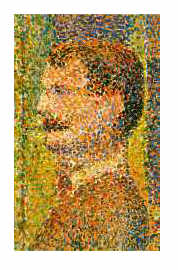 Continuing, he said, "You are the painting itself!" (like a Seurat painting). Another way to say it, he said is, "There is no observer, no one watching. You are not your body, you are the perception being created by your body... think of your body as a lens, a lens for awareness... It is aware in and of itself; the watcher and the watched are one and the same thing. Your perception of things is you. Your perception of yourself, your body, your environment, is you... your creation. We are all of it (the blue sky, the ocean... ), and many of the world's traditions recognize this, that we are not separate." Continuing, he said, "You are the painting itself!" (like a Seurat painting). Another way to say it, he said is, "There is no observer, no one watching. You are not your body, you are the perception being created by your body... think of your body as a lens, a lens for awareness... It is aware in and of itself; the watcher and the watched are one and the same thing. Your perception of things is you. Your perception of yourself, your body, your environment, is you... your creation. We are all of it (the blue sky, the ocean... ), and many of the world's traditions recognize this, that we are not separate."
"All of it is us... even the birds in the forest! How does this play into mythology? We are psychic beings... with color and emotion, and this is where mythology comes in... it's in our psychic domain."
Escobar quoted from Joseph Campbell about mythology as the collective version of the personal dream, "Myths are public dreams, dreams are private myths." He continued, citing C.G. Jung's ideas about the shared collective unconscious. He also discussed the ways we categorize our perceptions, and that many traditions recognize "maya" or illusion in contrast to "reality."
Escobar continued, saying that he views these "qualia" as essential electromagnetic fields, and that each pattern has specific properties associated with it. He discussed photons as particles of light, with no mass (actually both a particle and a wave) that travel at light speed, and that they are the way we pattern light (energy) in our brain. He explained Einstein's Theory of Relativity, discussing that the faster you go, your time frame changes... the physics of the perception of motion. He also discussed the Theory of Special Relativity... and that there is no real observer, that everyone's perception is valid... that as you go faster and faster, your frame slows down... until at the speed of light, time stops; all electromagnetic impulses (photons) are timeless, ageless. Regarding all light, creation and destruction occur, are at the same moment and exist in a timeless state. He says many people, even physicists, don't talk publicly about this, since it appears hard to think about and we are so used to thinking about causality.
"I think ourselves, our experience has a timeless nature associated with it... Is it one eternal instant we are all sharing?" he continued. He has asked physicists if it is even possible to have multiple out - of -time states.
Escobar gave an example of flashlight circles on a rug: the part that's "you" doesn't go away when you turn off the light... and we see other parts. What happens when we get information about other people at other times, information beyond ourselves, like premonitions and telepathy? He returned to the discussion of Jung's ideas about the collective unconscious and archetypal patterns... and to the concepts of "Brahma" and "God." We continued discussing meditation and health and ways of healing using the mind... that we are in collaboration, we are individuals sharing experiences. He noted the early experiences of infants; that the neurons we use are the ones we keep, as neural pathways develop; and he asked, "What (else) exists in that (early) potential?"
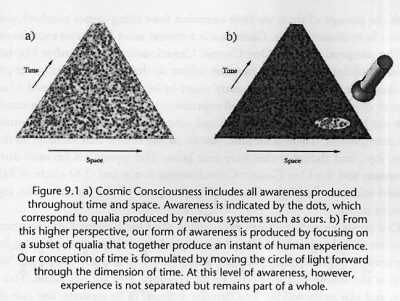
During the lecture, many of us in the room felt that "aha" experience of catching a momentary glimpse of the unseen mystery, the "reality" behind (or within) the "illusion." For instance, there are spaces in the molecules that make up what I perceive as my very solid chair. Plus, what are the perceptions of these other creatures (and plants) who share this world with me and can see, feel, smell, hear, perhaps taste, and touch a "reality" of this world that is so different from my reality? Questions arose about our seemingly "mystical" experiences and glimpses beyond everyday "reality", which many persons present had experienced. Escobar felt that it is important to share our mystical experiences with one another... that perhaps we are approaching another jump in awareness. He cited the language changes and awareness shifts that appear to have occurred during the millions of years of human life on earth.
For me, this lecture and discussion were very exciting and hopeful. I hope that I have transmitted these bits of it accurately. I suggest reading Alex Escobar's book. He has given us permission to quote from it here and excerpts follow.
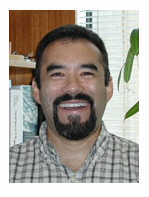 Alexander Escobar, Ph.D. is a Senior Lecturer in the Department of Biology at Emory University in Atlanta, Georgia. He received a Bachelor of Science degree in Genetics and a Doctoral degree in Biochemistry from the University of California. He has published scientific papers based on his research. His religious studies began as a young child while attending Catholic schools in his native San Francisco and have expanded throughout his adult life to include all the major religions of the world. It is Dr. Escobar's belief that religions and science offer descriptions of the same universe and that to truly understand the cosmos we must consider both. Alexander Escobar, Ph.D. is a Senior Lecturer in the Department of Biology at Emory University in Atlanta, Georgia. He received a Bachelor of Science degree in Genetics and a Doctoral degree in Biochemistry from the University of California. He has published scientific papers based on his research. His religious studies began as a young child while attending Catholic schools in his native San Francisco and have expanded throughout his adult life to include all the major religions of the world. It is Dr. Escobar's belief that religions and science offer descriptions of the same universe and that to truly understand the cosmos we must consider both.
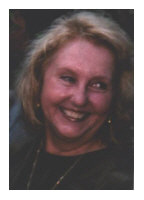 Mary Davis chairs Publications for the Mythic Imagination Institute. Davis was elected five times to the Atlanta City Council, serving there twenty years, she hopes making a difference for Atlanta's people. Consultant in public policy, strategic planning, public relations, marketing, writing, editing, and real estate; yoga teacher; actress; civic leader and activist; she says, "You name it, I have done most of it!" Davis especially enjoys her three adult daughters, six young grandchildren, and her friends, plus, of course, her involvement with the Mythic Imagination Institute, Emory University, and the Jung Society of Atlanta. Mary Davis chairs Publications for the Mythic Imagination Institute. Davis was elected five times to the Atlanta City Council, serving there twenty years, she hopes making a difference for Atlanta's people. Consultant in public policy, strategic planning, public relations, marketing, writing, editing, and real estate; yoga teacher; actress; civic leader and activist; she says, "You name it, I have done most of it!" Davis especially enjoys her three adult daughters, six young grandchildren, and her friends, plus, of course, her involvement with the Mythic Imagination Institute, Emory University, and the Jung Society of Atlanta.
Return to the Mythic Passages Menu
Subscribe to the Mythic Passages e-zine
Return to Passages Menu
Subscribe to the Passages e-zine
|
